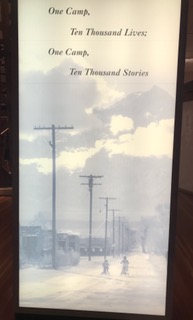On August 10, 1988, President Ronald Reagan signed the Civil Liberties Act, an official apology to the Japanese people living in America for the creation of Japanese internment camps during World War II (WWII). Last week, I had the opportunity to visit Manzanar,California, one of the relocation camps, now a national historical site. At one time Manzanar, existing on windy plains on the eastern side of Sierra Nevada Mountains, was home to more than 10,000 Japanese families. Experiencing the camp through a movie with survivors telling their stories and participating in an interactive housing display was sobering.

Japanese internment camps were created by President Franklin Roosevelt through Executive Order 9066, signed February 19, 1942. This order led to the loss of property and incarceration of more than 110,000 Japanese, two-thirds American citizens. The relocation camps existed from 1942 to 1945. Those sent to the camps were given several days notice before being evacuated to the camps. Each person was allowed to take only one suitcase. These Japanese, our fellow neighbors, had committed no crimes, had no trials or convictions and yet they had to leave their homes and businesses. These individuals were incarcerated simply because they were Japanese. The majority of those relocated to camps were identifiably Asian from the West coast.Some had sons who fought for the United States and lost their lives while their parents were interned. The Japanese camps were motivated by racial prejudice, war hysteria and failure of political leadership. Executive Order 9066, included Germans and Italians but very few of these groups were ever relocated because their ethnicity is not as visible and because racism in America has long roots.
 The internment camps were surrounded by barb wire, had guard towers and armed guards to keep the Japanese separate. The living quarters were drafty barracks. Group showers and latrines made privacy impossible. Despite the desperate conditions, the Japanese in Manzanar remained committed to America. No Japanese in a camp was ever accused of conspiracy.
The internment camps were surrounded by barb wire, had guard towers and armed guards to keep the Japanese separate. The living quarters were drafty barracks. Group showers and latrines made privacy impossible. Despite the desperate conditions, the Japanese in Manzanar remained committed to America. No Japanese in a camp was ever accused of conspiracy.
Manzanar provides an instructive lesson on America’s journey from right to wrong in the area of civil rights. When we feel threatened as a people, we can truly become ugly Americans. The hope of the Japanese who worked to pass the Civil Liberities Act of 1988 was to provide an apology to the Japanese American children who experienced the camps and to try to ensure that public policy mistakes like Executive Order 9066 are never repeated.
President Trump has opened his administration with a flourish of his pen and a flurry of Executive Orders. Manzanar is a vivid reminder that Executive Orders have the ability to dramatically change lives with a pen stroke. The Japanese internment camps were created by a Democratic President. Public policy mistakes are not the providence of one party or the other. Democracy demands transparency and public scrutiny. One person should not be able to take away the civil rights of an entire group of people through administrative fiat.
“A nation as a society forms a moral person, and every member of it is personally responsible for his society.” Thomas Jefferson

